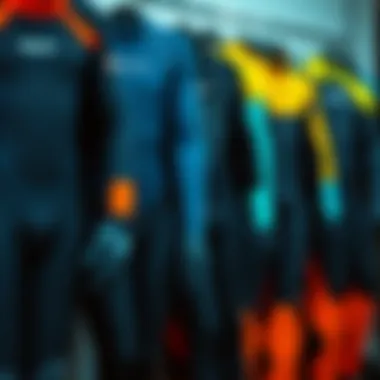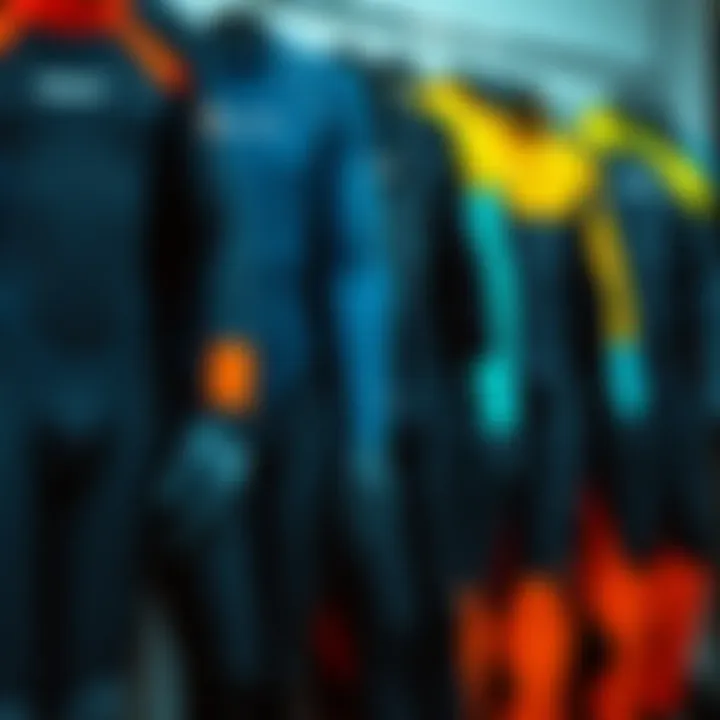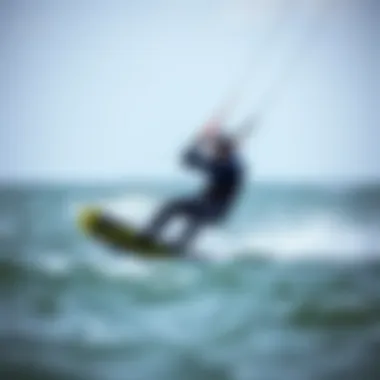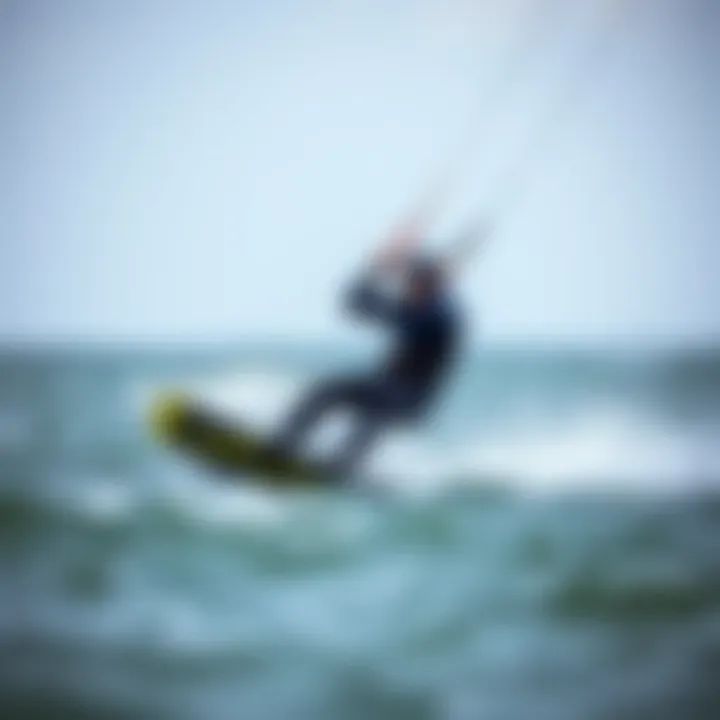Choosing the Right Winter Wetsuit for Kiteboarding


Intro
For kiteboarding enthusiasts, winter may seem like a season better spent by the fireplace than on the water. However, with the right winter wetsuit, those icy winds and chilly waters transform from deterrents into exhilarating challenges. Proper understanding of winter wetsuits is not just about keeping warm; it's a gateway to extend your kiteboarding season, enhancing your performance and comfort during those brisk sessions.
Diving into the world of winter wetsuits, we will explore essential elements such as the materials, styles, thickness, and the factors you need to consider when choosing the right wetsuit. Whether you're a seasoned kiteboarder or just starting to dip your toes into winter waters, this guide aims to equip you with the knowledge required for making informed decisions that will ultimately enhance your kiteboarding experience in colder conditions.
Equipment Insights
Key Elements of Wetsuit Construction
Understanding the build of a wetsuit is crucial in selecting the appropriate one for winter kiteboarding. Wetsuits come in various thicknesses, typically ranging from 3mm to 6mm, with some specialty suits going thicker. A suit that’s too thin may not provide adequate insulation, while an overly thick suit can restrict movement. When choosing your wetsuit, consider the following:
- Material Composition: Neoprene is the primary material used, but not all neoprene is created equal. You will find variations like limestone neoprene, which is more environmentally friendly and offers superior insulation.
- Seams: Flatlock seams are durable, but if you want to ensure waterproof integrity, look for blind-stitch seams or sealed seams, which prevent water from seeping in.
- Lining: Some suits come with thermal linings that add an extra layer of heat retention, which can be a game changer during those frigid water sessions.
Latest Gear Reviews
As the market evolves, so does the technology behind wetsuits. Noteworthy brands like O’Neill, Rip Curl, and Patagonia continually innovate, releasing suits designed specifically for kiteboarding. For instance, an advanced wetsuit like the O'Neill Psycho Tech is lauded for its flexibility and warmth. Here’s a quick look at promising options:
- Rip Curl Flashbomb: Known for its internal thermal lining and quick-dry technology, making it ideal for repeated sessions.
- Patagonia R3 Yulex: Composed of natural rubber, this sustainable choice provides excellent insulation without compromising on performance.
Before buying, it helps to keep an eye on customer reviews and expert opinions on sites like Reddit or weather-related forums.
Essential Gear Maintenance
Keeping your wetsuit in prime condition goes a long way in prolonging its life. Here are some maintenance tips:
- Rinse After Use: Always rinse your wetsuit in fresh water after each use to remove salt and sand.
- Drying Techniques: Hang your wetsuit inside out on a wide hanger in a cool place. Avoid direct sunlight, as this can degrade the neoprene.
- Storage: When not in use, store it in a dark area, as extended exposure to light and heat can warp the material.
Proper care not only extends the life of your wetsuit but also keeps you safe and comfortable in the water.
By being mindful of these aspects, you can enhance your overall experience while kiteboarding in the winter. Let's now navigate through the techniques that can elevate our kiteboarding skills to match the challenges that winter surf brings.
Prologue to Winter Wetsuits
When the temperature dips and the winds pick up, kiteboarding enthusiasts might find themselves pondering the merits of a winter wetsuit. The right wetsuit is not merely an accessory; it is the first line of defense against the biting cold of winter waters. Kiteboarders venturing into frigid waves must grasp the critical role a winter wetsuit plays in their performance and safety.
The Purpose of a Wetsuit in Winter Conditions
A wetsuit functions primarily to provide insulation and protect the body from chilly water, which can sap heat from even the most stalwart athletes. The primary goal is to keep body heat within a thin layer of water trapped between the neoprene suit and your skin. This method of insulation is what separates the seasoned kiteboarder from the weekend warrior.
Moreover, as you skim across the surface of icy waters, the wetsuit aids in buoyancy, allowing for better movement and control. It shields you from wind chill as well, particularly during gusty conditions, effectively acting like a second skin that works hard to retain warmth while allowing freedom of movement.
The right wetsuit can extend your time on the water, preventing not just discomfort, but also serious risks related to hypothermia which can set in far quicker than one might expect.
Though it may seem that all wetsuits serve the same purpose, winter wetsuits are specifically crafted with extra thickness and advanced thermal materials. When discussing the importance of these suits, one must also consider factors such as:
- Insulation: Thicker suits provide greater warmth, while special linings help trap heat.
- Flexibility vs. Warmth: Finding the right balance allows for easy movement on the board.
- Seam Construction: Proper seam technology ensures no cold water leaks in.
- Fit: An ill-fitting wetsuit can do more harm than good; you need one that hugs your body closely without being restrictive.
Ultimately, winter wetsuits are paramount for anyone who seeks to enjoy kiteboarding, regardless of the chill. They are indispensable tools that combine warmth, flexibility, and durability, allowing kiteboarders to fully embrace the adventure of winter riding.
Material Composition of Winter Wetsuits
When it comes to winter wetsuits, the composition of the fabric is paramount. It affects everything from thermal insulation to flexibility and durability. Choosing the right material is like picking the right tool for a job; it can make the difference between a comfortable or a miserable experience out on the water. Let’s dive deeper into these intricacies to understand what makes up a quality winter wetsuit and how these components contribute to your performance and comfort.
Neoprene: The Standard for Thermal Insulation
Neoprene has established itself as the gold standard in wetsuit materials. This synthetic rubber is renowned for its excellent thermal insulation properties. When kiteboarding in frigid waters, neoprene traps a thin layer of water between your skin and the wetsuit; your body then warms this layer, effectively acting as a barrier against the cold.
A good-quality neoprene wetsuit allows enough movement so you can maintain your kiteboarding skills without feeling like you're wearing a straitjacket. Brands like O'Neill and Rip Curl utilize different thicknesses of neoprene to cater to various temperature conditions, allowing for increased flexibility while still keeping warmth intact. It is worth noting that neoprene can also be combined with additional materials to enhance its properties.
"The right neoprene can mean the difference between shredding waves and shivering on the shore."
Choosing the thickness of neoprene is critical. For instance, a 4/3mm wetsuit is typically recommended for cold water, while a 5/4mm is suited for icy climates. Additionally, texture matters here too. Smoothskin neoprene offers less drag in the water and can provide extra insulation.
Alternative Materials and Their Benefits
While neoprene is the frontrunner, alternative materials have begun to carve out a niche in the wetsuit market. For example, limestone-based neoprene is gaining traction. It is generally more sustainable because it’s derived from a natural resource rather than petroleum. This type boasts similar insulation properties but with a reduced environmental footprint.
Other materials like Yamamoto rubber, often referred to as “eco-friendly neoprene,” offer flexibility and buoyancy advantages. It’s made from the rubber tree and is less compressive than traditional synthetic neoprene, staying warm even at greater depths or longer durations in the water.
Furthermore, wetsuits lined with advanced technologies such as quick-dry fabrics or thermal linings can enhance user experience. Quick-dry materials help in managing moisture, while thermal linings efficiently capture and retain body heat.
The Key Benefits of Alternative Materials:
- Sustainability: Reducing environmental impact by using natural or recycled content.
- Performance: Often offer comparable, if not superior, thermal insulation and flexibility.
- Comfort: Innovations lead to a snugger fit that improves performance and decreases water entry.
Choosing the Right Thickness for Your Wetsuit
Selecting the correct thickness for your wetsuit is crucial for kiteboarding in winter. As adventurous souls braving the chilly waters, kiteboarders need to ensure that they strike the right balance between thermal protection and ease of movement. Getting this part right can significantly enhance your on-water experience, keeping you warm while allowing you the fluidity needed to perform tricks and maneuvers.
Why Thickness Matters
Wetsuits are designed to keep the body warm by trapping a thin layer of water between the suit and the skin, which your body gradually warms up. However, the thickness of the wetsuit directly impacts your heat retention capability.
"A wetsuit too thin will leave you shivering; too thick and movement feels like you're wrapped in a comforter."
Understanding Wetsuit Thickness Ratings
Wetsuit thickness is usually measured in millimeters, often presented in the format of two numbers, like 3/2mm or 4/3mm. The first number represents the thickness of the neoprene in the torso area, while the second number represents the limbs. Here’s a quick breakdown:
- 2mm: Great for warmer water or spring conditions; minimal insulation.
- 3/2mm: A solid choice for early fall or late spring; offers a balance between warmth and flexibility.
- 4/3mm: Best for cold conditions; provides substantial warmth without sacrificing mobility.
- 5/4mm and above: Suitable for the coldest conditions or extreme winter sessions, particularly in early mornings or late afternoons when temperatures can drop significantly.
When evaluating which thickness suits you best, it’s key to consider personal body temperature regulation, as each individual can endure cold water differently.
Evaluating Climate and Water Temperatures
Climate plays a significant role in your wetsuit choice. For those kiteboarding in harbors or areas known for frigid waters, thicker suits become essential. Conversely, in more temperate climates, lighter wetsuits may suffice.
To guide your choice, refer to temperature ranges associated with typical winter kiteboarding conditions:
- Above 60°F (15°C): A 2mm or springsuit works fine.
- 50°F to 60°F (10°C to 15°C): A 3/2mm wetsuit is advisable.
- Below 50°F (10°C): Opt for a 4/3mm or thicker.
- Extreme Cold (below 45°F, 7°C): Consider a 5/4mm or an appropriate drysuit.
Keep An Eye on Wind Factors
Wind chill is another element that can dramatically affect comfort levels. High winds lower the perceived temperature, thereby requiring added insulation. Utilizing heat-retention accessories such as hoods, gloves, and booties can help combat these wind effects, allowing for a more enjoyable session on the water.
For more details on water temperatures relevant to your area, you might want to check resources like NOAA or Swellinfo for insights to optimize your wetsuit selection.


Types of Winter Wetsuits
When it comes to navigating the brisk waters during wintertime kiteboarding, the choice of wetsuit can make all the difference. Different types of winter wetsuits cater to a variety of conditions and preferences, ensuring that every rider finds suitable protection against the chill. Understanding these types not only aids in making informed decisions but also boosts overall performance on the water.
Full Suits: Comprehensive Coverage
Full suits are the gold standard for kiteboarders braving colder climates. These suits cover the entire body, including arms and legs, which keeps heat retention at its peak. A full wetsuit typically ranges from 3mm to 5mm in thickness, providing insulation needed for frigid temperatures. The seamless construction and snug fit enable better movement while preventing water from seeping in, which can sap warmth.
The benefits of using a full suit extend beyond warmth. With a complete coverage design, it protects against sun exposure, jellyfish, and other marine life that you might encounter while riding. In addition, many brands offer full suits with thermal linings, adding extra warmth without sacrificing flexibility. Key features to look for include:
- Seam technology: Flatlock seams may provide some warmth, yet glued and blind stitched seams offer superior waterproofing.
- Zipper options: Back zippers or front zippers can affect how the suit fits and feels, so choosing what works best for your comfort is crucial.
Springsuits: A Versatile Option for Transitional Weather
Springsuits represent a halfway point between a full suit and shorties, ideal for those taming winter squalls during less severe conditions. These suits often come in 2mm or 3mm thickness and cover the torso while leaving arms and legs exposed, offering more freedom of movement yet still keeping the core warm.
They’re fantastic for unpredictable weather, where you might face both sun and chilly gusts. The shorter cut makes it easier to exit and enter the water quickly, providing a delightful balance. Springsuits are particularly appealing for kiteboarders who ride in changing conditions or engage in various water sports. Key considerations include:
- Durability: Make sure to assess the material quality to avoid wear and tear.
- Fit: A snug fit ensures that water doesn’t enter, while still allowing for comfort and mobility.
Shorties: When Minimalism Meets Functionality
Shorties, as they're known colloquially, are another excellent option, particularly for those who seek mobility without compromising too much on thermal protection. These wetsuits have short sleeves and short legs, making them perfect for warmer, yet still brisk, waters. They are ideal for spring and autumn kiteboarding sessions when temperatures are mild.
Despite having less coverage, shorties can still provide sufficient warmth for quick rides. They allow for greater ease of movement and are typically made from thinner materials—1.5mm to 3mm thick. Ideal for those sunny days when temperature rises but the water remains cool. Here are a few benefits:
- Lightweight: Less bulk means easier to maneuver, especially in tricky kiteboarding scenarios.
- Quick drying: With less fabric, they often dry faster, making them a practical choice for back-to-back sessions or day trips.
Choosing the right type of wetsuit significantly impacts your comfort and performance on the water. Therefore, understanding the differences between full suits, springsuits, and shorties allows kiteboarders to better adapt to variable conditions, helping them make the most of their winter riding adventures.
"A great wetsuit is an investment in your comfort and performance. Choose wisely!"
For further reading on wetsuit types and their specifications, consider checking articles at Wikipedia or forums such as Reddit's kiteboarding community for user experiences.
Features to Look for in a Winter Wetsuit
When kiteboarding in winter, a well-chosen wetsuit can mean the difference between a thrilling day on the water and a frigid experience that sends you packing. In this section, we will dive into the critical aspects that make up a quality winter wetsuit. From seams and zippers to internal linings, every feature contributes to comfort, flexibility, and warmth. The right wetsuit should work as a second skin, offering not just protection from the elements but also optimizing your performance in cold water.
Seam Construction: Flatlock vs. Glued and Blind Stitched
Seam construction plays a crucial role in maintaining warmth and flexibility in winter wetsuits. There are two primary types you’ll encounter: flatlock seams and glued (blind stitched) seams.
- Flatlock seams: These are sewn together and then laid flat, allowing for a comfortable fit against the skin. However, while they are more breathable, they can let in water over time, which isn’t ideal for the coldest sessions.
- Glued and Blind Stitched seams: This method involves gluing the edges of the neoprene together and then stitching just enough to hold them in place without penetrating the material. This provides a tighter seal against water ingress while enhancing insulation. While this type generally requires more craftsmanship, the benefits justify the investment, especially in chilly waters.
"The type of seam construction can be as vital as the suit's thickness—less water leakage equals more warmth and a better day kiteboarding."
Zipper Placement and Its Impact on Flexibility
Zipper placement can greatly affect how well a wetsuit fits and moves with the body. Most winter wetsuits feature one of two styles: back zip and chest zip.
- Back zip: Usually easier to put on and take off, back zippers can sometimes inhibit flexibility, especially around the upper body during movement.
- Chest zip: These zippers offer a more streamlined profile, minimizing water entry at the neck. They can create a more snug fit, enhancing your range of motion, which is vital for kiteboarding maneuvers.
A well-placed zipper can allow for unrestricted movement while ensuring you're not left shivering in the water. Assessing how a suit's zipper functions is a key part of your fitting process.
Internal Linings: Fleece vs. Neoprene Variants
The internal lining of your wetsuit can significantly enhance comfort. You'll typically find two types: fleece linings and smooth-skinned neoprene variants.
- Fleece linings: These create a cozy layer against the skin. The soft texture not only provides warmth but also wicks moisture away, keeping sweat from dampening the insulating properties of the suit.
- Smooth skin neoprene: Often used for its resilience against wind and cold water, this material lacks the plush feel of fleece but offers excellent hydrodynamics. It's better for those who prioritize performance over warmth.
Ultimately, the choice between these materials depends on personal preference and the conditions you face. Some kiteboarders opt for a combination to balance warmth and performance effectively.
In summary, making informed decisions about the features of your wetsuit can enhance your overall kiteboarding experience. Understanding the importance of seam construction, zipper placement, and internal linings equips you to select a suit that best fits your needs and keeps you performing at your best.
Color and Design Considerations
Choosing the right color and design for a winter wetsuit goes beyond mere aesthetics; it's about blending functionality with personal style. In the sport of kiteboarding, where conditions can be unpredictable, the hues and patterns of your gear can influence not just the visual appeal, but also your safety and performance on the water.
Color Choices and Their Practical Implications
Colors often play a functional role. Bright colors such as red, yellow, and orange can significantly improve visibility, especially in tumultuous waters or low-light conditions common in winter. Meanwhile, darker shades, while stylish, may lead to excessive heat absorption when sitting on the beach post-session but they're less visible in water, a factor that might be worth considering. Having good contrast between your suit and the water can be the difference between an enjoyable session and one filled with anxiety about being seen.
Additionally, it’s possible to find suits that combine both high visibility and style.
When picking a wetsuit, think about the kind of environments you'll be in. If you're venturing into areas where safety is paramount, like crowded beaches or choppy waters, aiming for colors that stand out is wise. On the flip side, if you ride solo in serene and isolated spots, you might enjoy the understated elegance of more muted tones. Here are some aspects to keep in mind about color choices:
- Visibility: Bright colors can help you be spotted easily by fellow kiters and boaters.
- Heat Retention: Dark colors retain heat better, but can also lead to overheating when out of the water.
- Stylishness: Choosing colors you enjoy wearing enhances your experience on the water.
Ultimately, your personal preference paired with practical considerations should guide your choice in colors.
Trends in Wetsuit Design
Wetsuit design is ever-evolving, reflecting shifts in both technology and consumer preferences in the kiteboarding community. Recent trends have leaned towards not just the functionality of the suit, but also personalization and style. For instance, brands are experimenting more with unique prints and graphics that reflect an individual’s personality.
There is a movement towards streamlined designs that offer better mobility, allowing the rider to maneuver easily while kiteboarding. Functional zippers, mesh panels, and bonded seams are increasingly common, enabling greater comfort and range of motion.
A few trends to observe in modern wetsuit design include:
- Color Blocked Styles: Utilizing contrasting colors for dynamic visual appeal and added safety.
- Eco-Friendly Materials: With sustainability in focus, more companies are creating suits from recycled materials or updating their manufacturing processes.
- Custom Fit Options: Brands now offer customized fits, allowing enthusiasts to select specific dimensions to enhance comfort and performance.
Stylish yet functional, the future of wetsuit design is all about marrying aesthetics with enhanced performance.
As you gear up for your kiteboarding adventures, it's crucial to recognize that color and design are not just superficial choices. They can impact your safety, performance, and overall enjoyment on the water. Prioritize what matters most to you, and stay ahead of trends to make an informed decision in your wetsuit purchase.
Maintaining Your Winter Wetsuit
Keeping your winter wetsuit in top shape is crucial for kiteboarders who value both performance and comfort during their chilly adventures on the water. Just like a well-oiled machine, a properly maintained wetsuit provides better insulation, flexibility, and longevity, which in turn enhances your overall experience. Neglecting it can lead to accelerated wear and tear, not to mention discomfort in those brisk waters.
Cleaning and Storage Techniques
Cleaning your wetsuit might feel like an afterthought after a long day on the water, yet it’s an essential practice. A good rinse with fresh water after each use washes away salt, sand and other debris that can degrade the suit's materials over time. It’s best to immerse your wetsuit in a bath of cool freshwater for 10-15 minutes, gently scrubbing the interior and exterior with your hands to remove stubborn contaminants.
After it's squeaky clean, allow the wetsuit to dry naturally. Avoid hanging it by the shoulders; this could stretch the material. Instead, consider using a hanger that supports the entire width of the suit, or lay it flat in a cool, shaded area. Direct sunlight can cause the neoprene to deteriorate, so it’s good practice to avoid prolonged exposure.


When it comes to storage, think about the environment where your wetsuit will rest. Ideally, find a cool, dry space to hang it. If you’re storing it for an extended period, roll the wetsuit gently instead of folding it, preventing creases that could develop into larger problems later on.
Identifying and Repairing Common Damages
Recognizing the signs of wear and addressing minor repairs can save you a significant amount of hassle down the road. Over time, you might notice cracks or small punctures in your wetsuit. If you catch these early, you can patch them up yourself with a simple neoprene adhesive. Just apply a small amount to the damage, allow it to cure according to the product instructions, then smooth it out for a seamless finish.
Zipper issues can crop up as well. A stuck zipper can usually be resolved by cleaning it with lubricant or wax designed for wetsuits and zippers. If the zipper needs replacing, do not attempt it yourself; take your wetsuit to a professional.
It's important not to underestimate the significance of regular maintenance. Treat your wetsuit with care, and it’ll treat you the same on those winter kiteboarding escapades, keeping you warm and agile when conditions are less than inviting.
"Regular care for your wetsuit is a small effort that yields a big reward in performance and enjoyment."
For more detailed guidance on wetsuit care, you might explore resources from Wikipedia or visit kiteboarding communities on Reddit.
Remember, a well-maintained wetsuit isn’t just about preserving your investment; it’s also key to enjoying your time tackling the waves in winter conditions.
Market Trends and Innovations
Exploring the landscape of winter wetsuits in kiteboarding reveals a tapestry of market trends and innovations. The evolution of these wetsuits is influenced by various factors including advancements in technology, changing consumer preferences, and an ever-growing emphasis on sustainability. Understanding these trends is crucial not only for making informed purchasing decisions but also for enhancing the overall kiteboarding experience during the colder months.
Emerging Technologies in Wetsuit Manufacturing
Modern wetsuit manufacturing is experiencing a renaissance, marked by emerging technologies that push the boundaries of performance and comfort. One key innovation comes from developments in materials science, particularly the introduction of highly elastic and lightweight neoprene variants. These high-performance materials offer a better fit, allowing for increased mobility and less water entry, which translates into enhanced warmth and flexibility on the water.
- Ultraspan Neoprene: A newer iteration that boasts remarkable stretchability, enabling kiteboarders to move freely without restriction.
- Graphene-infused Wetsuits: Integrating graphene has shown to improve thermal insulation significantly, while also maintaining lightness.
Manufacturers are also experimenting with new sealing and stitching techniques. For example, the use of liquid-sealed seams helps to minimize water penetration while enhancing durability, making those winter sessions far more comfortable. Consumers today expect more from their gear, and companies are responding in kind, creating wetsuits that not only meet but often exceed these expectations.
Sustainability in Wetsuit Production
As kiteboarders become more aware of environmental impacts, the demand for sustainable production methods in wetsuit manufacturing is gaining momentum. Companies are increasingly adopting eco-friendly practices, from responsibly sourcing materials to utilizing recycled packaging. For instance, some brands are now creating wetsuits from recycled materials, significantly reducing waste.
Sustainability in wetsuit production isn’t just a trend; it's vital for the future of our oceans and the sports we love.
Here are some notable sustainable practices:
- Bio-based Neoprene: Several manufacturers are shifting towards bio-based alternatives that reduce dependency on fossil fuels.
- Recycling initiatives: Some brands offer recycling programs where users can send back old wetsuits in exchange for discounts on new purchases.
These steps are not only beneficial for the planet but also resonate with consumers who are increasingly prioritizing eco-conscious brands. Providing transparency about these practices helps build trust and loyalty among customers who are keen on reducing their environmental footprint while enjoying their kiteboarding adventures.
In summary, staying informed about market trends and innovations in winter wetsuits can significantly impact a kiteboarder's experience. With emerging technologies enhancing performance and a focus on sustainability guiding production, today's kiteboarding enthusiasts are better equipped to make choices that align with their needs and values in cold water conditions.
Selecting the Right Fit
Getting a wetsuit that fits just right is like finding the holy grail for kiteboarders, especially when it comes to winter sessions. A well-fitted suit doesn’t just keep you warm but also allows for optimal movement and comfort. If it’s too loose, water can seep in and chill you to the bone. On the flip side, if it’s too tight, you might feel constricted, and nobody wants that hassle on the water. Therefore, understanding how to select the right fit is crucial for both performance and enjoyment.
How to Measure for an Optimal Fit
Measuring for the perfect wetsuit isn’t rocket science, but it does require a touch of diligence. Start by taking a good measurements of your body. Here’s a simple guide:
- Chest: Measure around the fullest part of your chest, keeping the tape snug but not tight.
- Waist: Measure right above your hips, where your waist naturally goes in.
- Hips: Stand with your feet together and measure around the widest part of your hips.
- Inseam: From your crotch down to your ankle, ensuring you’re standing straight.
- Height: Measure without shoes as this can make a difference.
Here’s a tip: It’s also smart to wear the undergarments you plan to use with your wetsuit while measuring. It gives a more accurate picture of how the wetsuit will feel in real conditions. If you find that you are straddling the line between two sizes, it’s often better to size up. A snug fit is great, but you don’t want to be wrestling with your suit to get it on or off.
Brands and Their Sizing Standards
When it comes to wetsuits, each brand has its own sizing chart, and they can vary significantly. For example, O’Neill might have a different cut compared to Rip Curl. Here’s what to keep in mind:
- Understand Brand Charts: Always refer to the specific sizing chart for the brand you’re considering. Many brands have unique cuts that can impact how well the suit sits on your body.
- Read Reviews: Checking online forums or reviews can help understand how true-to-size a particular brand runs. You might find that a suit fits smaller or larger based on other users’ experiences.
- Try Before You Buy: If possible, visit local shops and try on various brands. What works for one person might not work for you.
Getting the right fit can determine whether you'll enjoy long kiteboarding sessions or be left shivering and uncomfortable. Finding the right wetsuit that contours your body without causing any discomfort is well worth the effort.
"A wetsuit should hug you close like a second skin, providing warmth and agility—the perfect balance for the winter waves."
By following these steps for measuring and understanding brand sizing, you're setting yourself up for success on the chilly water. The more comfortable you feel in your wetsuit, the more focused you can be on your performance and enjoying your time on the waves.
Common Misconceptions about Winter Wetsuits
Understanding the common misconceptions regarding winter wetsuits is vital for kiteboarders who want to make informed decisions. A poorly chosen wetsuit not only affects comfort but can directly impact performance in the water. Many kiteboarders new to the sport or those who are accustomed to warmer waters adopt preconceived notions that can lead to uncomfortable experiences during cold weather sessions. By addressing these misconceptions directly, this section aims to equip enthusiasts with accurate knowledge about winter wetsuits, thereby improving their overall kiteboarding experience in cooler conditions.
Myths vs. Facts Regarding Warmth
There's no shortage of myths floating around about how effective winter wetsuits really are when it comes to warmth. One common belief is that thicker wetsuits automatically ensure warmer experiences. While thickness matters, it's not the only factor at play.
- Myth: Thicker Wetsuits Equal Better Warmth
In reality, the thickness of a wetsuit does contribute to warmth, but the material's quality and how it's designed are equally important. A thin but well-constructed wetsuit with thermal linings can outperform a thicker counterpart made from lower-quality materials. - Fact: Insulation Technology Matters
The best winter wetsuits utilize advancements in insulation technology to trap body heat effectively while allowing for mobility. For example, some brands incorporate materials that create an extra layer of warmth without adding bulk. Therefore, it’s best to evaluate wetsuits on insulation technology rather than thickness alone. - Myth: You’ll Always Be Warm
Many believe that as long as you wear a wetsuit, you won’t feel cold at all. This isn't entirely true. Extended exposure to frigid water can lead to a drop in body temperature, regardless of what you wear. The secret is to recognize your limits and come prepared with proper thermal layers beneath your wetsuit or additional thermal accessories like gloves and booties.
"Choosing the right wetsuit comprises understanding both insulation and your body's tolerance to the cold water. Don't let myths derail your experience."
The Reality of Performance in Cold Water
Performance in cold water isn’t just about warmth; it's also about how the wetsuit impacts your overall maneuverability and responsiveness in the water. Key considerations include:
- Impact on Mobility
Some kiteboarders falsely assume that thicker wetsuits restrict movement. While it's true that added thickness can create more resistance, modern wetsuit designs prioritize flexibility. Brands have shifted their focuss towards melds of stretchy materials and ergonomic designs, allowing a full range of motion even in colder conditions. - Buoyancy is Key
Another misconception is that wetsuits will make you sink in cold water. Though traditional thoughts suggest a thicker suit brings added buoyancy, a properly fitted wetsuit can provide just the right amount of buoyancy, facilitating smoother movements during kiteboarding. Too much air trapped in a poorly-fitted suit can lead to instability. - Adaptation to Conditions
Kiteboarding in cold water means adjusting to the dynamics of the environment, not solely relying on the wetsuit. The reality is that wind chill, water temperature, and your own physical condition contribute to how you will perform. Understanding these contributing factors can inform which kind of wetsuit you choose and whether additional gear is needed.
Ultimately, navigating through these misconceptions will foster informed choices, resulting in a safer and more enjoyable kiteboarding experience year-round.
Wetsuit Rental vs. Purchase Decisions
When it comes to kiteboarding in the winter chill, the question of whether to rent or purchase a wetsuit often arises. This decision is significant for a number of reasons. First and foremost, it directly affects both comfort and performance on the water. If you're pondering this choice, it's vital to weigh the pros and cons carefully.
Renting a wetsuit can be an excellent temporary solution for those who are just starting out or only plan to hit the water occasionally during the colder months. However, buying your own suit may be better suited for more committed kiteboarders. Consideration of factors such as frequency of use, fit, and ultimately, your budget can help steer your decision in the right direction.
"A good wetsuit can feel like a second skin; it's not just about keeping warm, it's also about enjoying every second out there."
When Rental is a Suitable Choice
Renting can be particularly advantageous in several scenarios. If you're testing the waters, so to speak, this option gives you flexibility without a long-term commitment. Picture yourself embarking on your winter kiteboarding adventure. You might not be sure yet how frequently you’ll go out or if you’ll stick with it long-term. Renting allows you to experience various wetsuit styles and fits, helping you identify what works best for your future needs.
Additionally, consider the type of trips you're planning. If you're hoping to travel to different locations, renting a wetsuit can ease those travel burdens. Packing up a wetsuit can take up a hefty chunk of space, and the idea of lugging it around may not be too appealing. Instead, you can pop into a local shop when you arrive and rent a suit tailored to the local conditions.
Advantages of Owning Your Wetsuit
On the flip side, owning your wetsuit comes with a slew of distinct advantages. For starters, comfort is paramount. A wetsuit that fits you perfectly can be a game-changer. Rental wetsuits often reflect a one-size-fits-all mentality, which may not offer the same snug fit you’ll get from your tailored option. A personalized fit ensures that you stay warm without sacrificing movement.


Moreover, consider the long-term cost. Renting can quickly add up, especially if you're planning to kiteboard extensively over several seasons. Owning a wetsuit may require an initial investment, but if you're committed to winter kiteboarding, it can save you money in the long run.
Additional Benefits of Ownership:
- Familiarity: You become accustomed to your own gear, allowing for better performance over time.
- Customization: You can upgrade or modify features based on your experiences and needs.
- Care and Maintenance: With your suit, you have better control over its care, prolonging its life significantly.
Impact of Wetsuits on Performance
When it comes to kiteboarding in the crisp embrace of winter, understanding how wetsuits influence performance can’t be trifled with. Beyond merely keeping you warm, these indispensable pieces of gear can drastically alter your riding experience. A wetsuit isn't just a second skin; it's a pivotal element that can enhance your stability, agility, and overall effectiveness on the water. Each detail, from the material quality to the fit, plays a role in determining how a rider interacts with their environment during those exhilarating, yet chilly, sessions.
How Wetsuits Affect Device Stability and Movement
The fit and functionality of your wetsuit directly correlate to how stable and responsive you are on the board. A well-fitted suit allows for free movement while ensuring that your body maintains an optimal temperature, which can lead to improved focus and performance. Loose areas can create drag as you cut through the water, negatively affecting speed.
For instance, the seams and cut of the suit matter immensely. A suit with glued and blind-stitched seams tends to be more water-resistant, while a full suit provides complete coverage, helping maintain your core temperature. Here’s how the wetsuit impacts stability and movement:
- Flexibility: The material, like high-quality neoprene, provides that much-needed stretch for maneuverability. You want your arms and legs to move naturally as you carve through the waves.
- Streamlined Design: A suit tailored for performance helps reduce water resistance. You shouldn't feel like you're fighting against your own gear.
- Reduced Fatigue: By keeping your body warm and flow restricted, the wetsuit allows you to focus your energy where it’s needed—on your skills and techniques instead of combating the cold.
"A snug fit can save you from potentially embarrassing wipeouts caused by lagging movements."
Relative Performance in Cold Conditions
Cold water conditions can be merciless, but a quality wetsuit can provide the warmth and protection needed to keep a kiteboarder in peak form. The thermal regulation properties of a wetsuit are crucial—they preserve body heat while allowing for a degree of breathability, ultimately impacting how well you ride.
In lower temperatures, the right wetsuit can mean the difference between a few frigid minutes and hours of enjoyment. Here�’s what to consider in terms of relative performance:
- Thermal Insulation: A thick suit offers better thermal insulation, but it shouldn't sacrifice flexibility. Balancing these factors is key, particularly in an activity driven by movement and precision.
- Water Friction: In cold conditions, friction can be a double-edged sword. A wetsuit's material and fit are vital to ensure that you’re gliding smoothly rather than being slowed down by cumbersome gear.
- Adaptability: As conditions frequently change, the ability of a wetsuit to regulate temperature and breathability keeps you agile. A versatile suit allows you to perform confident transitions between tricks without losing warmth or strength.
Understanding Thermal Regulation
Thermal regulation is a critical aspect of kiteboarding in cold weather, where the ability to maintain body heat can directly affect both comfort and performance on the water. For winter wetsuit wearers, understanding how thermal regulation works helps in making informed decisions about what type of wetsuit to choose, ultimately enhancing the kiteboarding experience in chilly conditions. The body must combat the frigid temperatures of the water while also maintaining sufficient mobility and flexibility to execute maneuvers.
Body Heat Retention Mechanisms
When kiteboarding, the body generates heat through physical exertion, but this heat can be lost swiftly in cold environments. Here are five mechanisms through which the body retains warmth:
- Layering Effect: Wearing thicker wetsuits traps air close to the skin, creating insulation. The air becomes a barrier against the cold water outside.
- Blood Flow Regulation: The body constricts blood vessels near the skin's surface to maintain core temperature. This physiological response keeps vital organs warm, but it's not without its limits. If water penetration is too high, it can counteract this mechanism.
- Neoprene Quality: Higher quality neoprene, which is commonly found in better wetsuits, traps even more air and enhances thermal retention. Choosing a suit with added insulation or lining can significantly improve warmth.
- Movement and Muscular Activity: Engaging in constant movement while kiteboarding creates friction and generates warmth. However, if a wetsuit is too restrictive, it can hinder movement, amplifying the risk of losing body heat.
- Wet Suit Seal: A snug-fitting wetsuit minimizes the amount of cold water that can flow inside, thus reducing heat loss.
Understanding these elements of body heat retention is essential. Kiteboarders should assess each of these mechanisms to select the right wetsuit that aligns with their riding style and the conditions they expect to face.
The Role of Water in Heat Loss
Water is a natural conductor of heat, which intensifies the challenge that kiteboarders face while remaining afloat in winter months. Here are several key considerations regarding how water influences heat loss:
- Conduction: Heat dissipates from the body into the colder water surrounding it at a faster rate than it does through air. This is a crucial factor as just a few moments in the water can lead to significant heat loss.
- Thermal Conductivity: Water has a thermal conductivity nearly 25 times greater than air. This stark difference emphasizes how essential thermal regulation is when engaging in winter kiteboarding.
- Layer Depth: When the wetsuit absorbs water, it creates a barrier of warmed water next to the skin. If the suit's thickness or fit is inadequate, cold water can seep in and disrupt this layer, causing the body to lose heat rapidly.
- Flow Rate: The speed at which water flows over the body can also affect heat loss. On a particularly windy day, for example, wind chill can exacerbate cooling and increase the risks associated with hypothermia due to rapid evaporation from wet skin.
"While kiteboarding can be an exhilarating experience, taking practical steps to understand thermal regulation ensures that you can focus on the thrill of the ride rather than the chill of the water."
To counteract these effects, kiteboarders should consider investing in high-quality wetsuits that provide better heat retention and minimize water flow. Weighing the factors contributing to heat loss can also help in selecting appropriate accessories such as gloves and boots, enhancing overall thermal regulation on those chilly winter days on the water.
User Experiences and Case Studies
User experiences and case studies serve as the heartbeat of understanding winter wetsuits within the kiteboarding community. These real-life insights from fellow enthusiasts, instructors, and seasoned riders provide invaluable perspectives that shine a light on the practical implications of various wetsuit features in cold weather conditions. By sifting through personal experiences, new users can navigate the complex landscape of selecting the right wetsuit while avoiding common pitfalls.
When it comes to selecting gear for winter kiteboarding, relying solely on specifications and material descriptions can leave gaps in understanding. User feedback can clarify how wetsuits actually perform in icy waters and brisk winds. The importance of this section lies in its ability to connect theoretical knowledge with practical application. It helps kiteboarders grasp what features truly make a difference, such as thermal insulation effectiveness, ease of movement, or even durability after multiple uses.
Feedback from Experienced Kiteboarders
Feedback from seasoned kiteboarders provides a firsthand look at how various wetsuits hold up in real-world conditions. Many kiteboarders stress the significance of a proper fit, highlighting that the difference between a tight and loose wetsuit can be the difference between a comfortable day on the water and a painful, shivering experience. Experienced riders often share stories of their wetsuits enduring freezing temperatures while still allowing for agility during intense maneuvers.
Kiteboarders also offer insights on the trade-offs between different wetsuit styles. For instance, full suits often get high marks for warmth but might restrict movement slightly compared to shorties or springsuits. Here are a few points that frequently come up in conversations:
- Layering Tips: Many riders recommend layering with rash guards underneath full suits for added warmth without sacrificing flexibility.
- Durability Issues: Some users report that certain brands develop leaks after a season or two, emphasizing the need for robust seam construction.
- Fitting Strategies: Riders suggest trying on multiple sizes and styles before making a purchase, as fit can vary widely across different brands.
Analysis of Winter Wetsuit Performance
Diving deeper into the performance aspects of winter wetsuits, analyzing user experiences can expose patterns about what features contribute to better performance in cold water. For instance, several kiteboarders noted how lighter wetsuits with thicker neoprene provided both warmth and flexibility, crucial for executing tricks.
Another repeated observation is how internal linings contribute to comfort during extended sessions. Riders favor wetsuits with plush linings that wick away moisture, as staying dry can significantly enhance comfort and performance.
When assessing these experiences, consider these factors:
- Heat Retention: Users often reference how certain brands manage to keep body heat retained effectively, especially during prolonged exposure to cold waters.
- Movement and Flexibility: Many feedback pieces underscore that flexibility is as critical as warmth. Riders who've tried multiple thicknesses often suggest that moderately thicker suits can provide a sweet spot that meets both needs.
- Wind and Water Resistance: Case studies reveal that wetsuits featuring wind-resistant panels are preferred for kiteboarding, as they help maintain body temperature against chilling winds.
In summary, user experiences and case studies not only enrich the discourse around winter wetsuits but serve as essential tools for both novices and experts alike. Engaging with this community and learning from its feedback can provide kiteboarders with the knowledge needed to make informed choices, ultimately enhancing their adventures in winter conditions.
Future Directions in Wetsuit Development
The future of wetsuit development is a captivating topic for kiteboarders seeking optimal performance in colder waters. With innovations constantly emerging, it’s an exciting time for enthusiasts who want to enhance their riding experience. The way wetsuits are evolving not only reflects advances in technology but also a growing awareness of sustainability and custom user experience. As kiteboarding is often influenced by the natural environment, the wetsuit industry must adapt to these changes, making it a pivotal aspect for anyone serious about their sport and comfort during winter sessions.
Predicted Advancements in Material Science
When it comes to material advancements, there's a significant shift happening. Manufacturers are now looking beyond the traditional neoprene commonly used in wetsuit construction. Future wetsuits might incorporate materials that are lighter, more flexible, and a step up in thermal insulation. Here are some key materials to watch:
- Bio-based Neoprene: This eco-friendly alternative seeks to reduce reliance on petroleum. It’s crafted from natural sources, lowering the environmental impact of wetsuit production.
- Graphene-infused Neoprene: Graphene offers incredible thermal efficiency, allowing a thinner suit to provide the same insulation as thicker models. This means less bulk and more mobility on the water.
- Aerogel: Known for being exceptionally lightweight and insulative, aerogel could revolutionize the way we think about warmth in wetsuits.
These advancements not only promise to keep kiteboarders warmer but also enhance flexibility, which is crucial for maneuvering during kitesurfing. A more mobile wetsuit can mean more agility, ultimately enhancing performance.
Emerging Trends in Customization and Fit
Customization in wetsuits is gaining traction, and rightly so. Every kiteboarder has their own preferences when it comes to fit and design. Advanced technology now allows for custom sizing, with companies offering tailored fits based on personal measurements. This trend is vital since a well-fitting wetsuit can make a world of difference in comfort and performance. Some notable trends include:
- 3D Scanning Technology: Some brands are utilizing 3D scanning to create a precise fit. This means less water can seep in, keeping warmth intact.
- Customizable Features: Options for knee padding, zipper types, and even color choices can help riders find their perfect balance between style and functionality.
- Integrated Smart Technology: Future wetsuits might include smart tech that can monitor body temperature and alert the rider about optimal conditions or even water quality.
In summary, as kiteboarding continues to grow, the wetsuit industry is responding with innovations that prioritize warmth, fit, and sustainability. For anyone passionate about kiteboarding, keeping an eye on these trends will provide extensive benefits when hitting the chilly waves.
"The trend toward customizing wetsuits is fantastic. Finding a fit that really works for you can make your time on the water that much better!"
As kiteboarders look to the coming years, the importance of informed purchasing decisions in terms of materials and fit can’t be understated.
Ending
As we wind down our exploration of winter wetsuits for kiteboarding, it's critical to underscore the significance of this topic. The right wetsuit can make or break your experience on the water during those chilly months. Attempting to kiteboard without adequate thermal protection not only risks discomfort but also health hazards like hypothermia. In retrospect, the decision-making process should never be taken lightly.
Recapping Key Insights About Winter Wetsuits
- Wetsuit Selection: Understanding the materials, thickness, and specific types of wetsuits tailored for winter conditions is pivotal. Neoprene remains the go-to for its insulating properties, while alternative materials may offer different advantages.
- Understanding Fit: An optimal fit is crucial. A wetsuit too loose can allow water to flow in and cool your body, while one that’s tight may restrict movement. Gaining the right measurements is essential here.
- Maintenance Matters: Keeping your wetsuit in top shape will prolong its life. Proper cleaning and repair techniques can prevent small tears or damages from developing into costly repairs.
- Market Trends: Staying informed on innovations in wetsuit technology can give kiteboarders an edge. With growing concerns about sustainability, some brands are moving towards environmentally friendly production practices.
"The right winter wetsuit does not merely provide warmth; it enhances performance, allowing kiteboarders to focus on their craft rather than the chill in the air."







